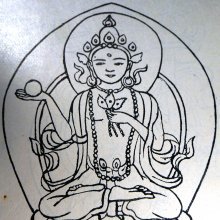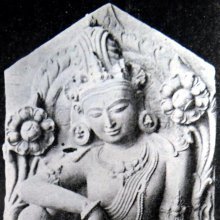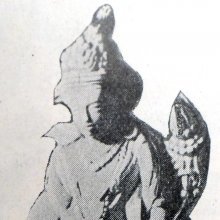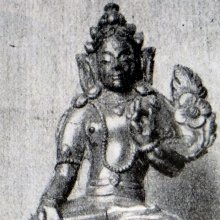Khagarbha: 9 definitions
Introduction:
Khagarbha means something in Buddhism, Pali, Hinduism, Sanskrit. If you want to know the exact meaning, history, etymology or English translation of this term then check out the descriptions on this page. Add your comment or reference to a book if you want to contribute to this summary article.
Images (photo gallery)
In Buddhism
Tibetan Buddhism (Vajrayana or tantric Buddhism)
Source: archive.org: The Indian Buddhist IconographyKhagarbha (खगर्भ) is another name for Ākāśagarbha: a Bodhisattva commonly depicted in Buddhist Iconography, and mentioned in the 11th-century Niṣpannayogāvalī of Mahāpaṇḍita Abhayākara.—his color is green; his symbol is the jewel.—The Bodhisattva Ākāśagarbha is also known by the name of Khagarbha, the words “Kha” and “Ākāśa” signify the same thing "Sky" Ākāśagarbha is the Bodhisattva who lives in the womb of the sky.
Khagarbha is described in the Sādhanamālā (under the Lokanātha-sādhana) as follows:—
Source: Wisdomlib Libary: Vajrayogini“Khagarbha is green as the sky, holds the Cintāmaṇi jewel in one hand and exhibits the Varada-mudrā in the other”.
Khagarbha (खगर्भ) is the name of a deity to be contemplated upon by a practicioner purifying his correspondences (viśuddhi), according to the 12th-century Abhisamayamañjarī. Khagarbha is alternatively known by the name Īrṣyāvajra because he destroyes envey (īrṣyā). The contemplation is prescribed as a preliminary ritual for a yogin wishing to establish, or reestablish the union with a deity.
Khagarbha is associated with the nostrils and the color yellow. He is to be visualised as holding an attribute in his right hand and a bell in his left. The deities of the sense organs and fields are the esoteric equivalents of the deities associated with the skandhas.
Source: academia.edu: The Structure and Meanings of the Heruka MaṇḍalaKhagarbha (खगर्भ) or Khagarbhaka is the name of a Vīra (hero) who, together with the Ḍākinī named Khagarbhakī forms one of the 36 pairs situated in the Hṛdayacakra, according to the 10th century Ḍākārṇava chapter 15. Accordingly, the hṛdayacakra refers to one of the four divisions of the sahaja-puṭa (‘innate layer’), situated within the padma (lotus) in the middle of the Herukamaṇḍala. The 36 pairs of Ḍākinīs and Vīras [viz., Khagarbha] are reddish yellow in color; they each have one face and four arms; they hold a skull bowl, a skull staff, a small drum, and a knife.
Source: OSU Press: Cakrasamvara SamadhiKhagarbha (खगर्भ) is the name of a deity [i.e., oṃ khagarbhāya svāhā], according to the Guru Mandala Worship (maṇḍalārcana) ritual often performed in combination with the Cakrasaṃvara Samādhi, which refers to the primary pūjā and sādhanā practice of Newah Mahāyāna-Vajrayāna Buddhists in Nepal.—

Tibetan Buddhism includes schools such as Nyingma, Kadampa, Kagyu and Gelug. Their primary canon of literature is divided in two broad categories: The Kangyur, which consists of Buddha’s words, and the Tengyur, which includes commentaries from various sources. Esotericism and tantra techniques (vajrayāna) are collected indepently.
General definition (in Buddhism)
Source: Wisdom Library: Dharma-samgrahaKhagarbha (खगर्भ) refers to the last of the “eight Bodhisattvas” (aṣṭabodhisattva) as defined in the Dharma-saṃgraha (section 12). The Dharma-samgraha (Dharmasangraha) is an extensive glossary of Buddhist technical terms in Sanskrit (e.g., aṣṭa-bodhisattva and Khagarbha). The work is attributed to Nagarguna who lived around the 2nd century A.D.
Languages of India and abroad
Sanskrit dictionary
Source: Cologne Digital Sanskrit Dictionaries: Edgerton Buddhist Hybrid Sanskrit DictionaryKhagarbha (खगर्भ).—name of a Bodhisattva: Sādhanamālā 49.14; one of ‘the eight Bodhisattvas’ (compare Kṣitigarbha, Maitreya, etc.), Dharmasaṃgraha 12.
Source: Cologne Digital Sanskrit Dictionaries: Monier-Williams Sanskrit-English DictionaryKhagarbha (खगर्भ):—[=kha-garbha] [from kha] m. Name of a Bodhi-sattva, [Buddhist literature]
[Sanskrit to German]
Sanskrit, also spelled संस्कृतम् (saṃskṛtam), is an ancient language of India commonly seen as the grandmother of the Indo-European language family (even English!). Closely allied with Prakrit and Pali, Sanskrit is more exhaustive in both grammar and terms and has the most extensive collection of literature in the world, greatly surpassing its sister-languages Greek and Latin.
See also (Relevant definitions)
Starts with: Khagarbhaka, Khagarbhaki.
Full-text: Irshyavajra, Ashtabodhisattva, Parahitodyata, Padmapani, Eight Bodhisattvas, Parahita, Udyata, Maitreyatmaka, Yakshadhipa, Vishkambhin, Khagarbhaka, Bodhisattva, Akashagarbha, Lokanatha.
Relevant text
Search found 1 books and stories containing Khagarbha, Kha-garbha; (plurals include: Khagarbhas, garbhas). You can also click to the full overview containing English textual excerpts. Below are direct links for the most relevant articles:
The Indian Buddhist Iconography (by Benoytosh Bhattachacharyya)




